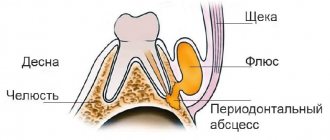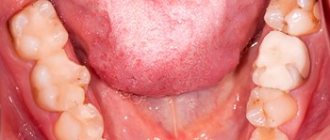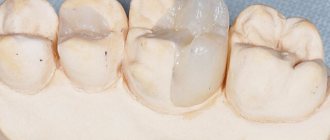Sometimes a seemingly healthy tooth, which has only recently been filled, suddenly begins to experience pain of varying intensity. This seems counterintuitive, but such situations are quite common in dental practice. Conventionally, these cases can be divided into two categories: a painful symptom immediately after treatment (within one to two days) or the appearance of discomfort months or years after the installation of the filling material.
In the first option, toothache is not always a pathology. The fact is that dissection (drilling) of organ tissue, treatment of a carious cavity with an antiseptic and installation of a cement material foreign to the enamel - all this treatment is a serious stress for the tooth. Therefore, at first, aching sensations in the tissues and a feeling of discomfort are considered normal. Another question is when the tooth under the filling hurts for more than two weeks. This state of affairs should alert a person and, at a minimum, force a telephone consultation with the treating dentist.
Often the cause of discomfort in the tooth is improper grinding of the filling during treatment, which does not correspond to the bite. To fix this, the dentist only needs to test the filling surface using carbon paper. If the fissure tubercles of the filling are too high, this will lead to an increase in the load on the treated tooth and, as a result, to injury to the soft tissues of the organ. The risk of displacement of the entire jaw bite, deformation of the tooth, or chipping of one of its walls increases.
The second variant of painful sensations in the tissues of a filled tooth appears a long time after the moment of treatment. A number of reasons may contribute to this.
Poor cleaning of the cavity
In rare cases, when installing a tooth filling, a dentist may simply not notice microscopic areas of carious lesions in the tissues. Despite treating the area with antiseptic drugs, a small amount of pathogenic bacteria may still remain in the tissues of the carious cavity. This will lead to the fact that in a year or two, the enamel in this area will be destroyed and the tooth in which the filling will ache. Often, such processes can occur chronically, without showing any symptoms for years and without needing treatment, and then one day the tooth gives acute pain, indicating the onset of inflammation in the nerve tissues.
A tooth hurts under an old filling: when do you need help from a dentist?
If the pain does not subside, you cannot do without a visit to the clinic. To make a correct diagnosis, the dentist needs to know all the symptoms associated with pain. The further method of treatment depends on the condition of the teeth and adjacent tissues. As a rule, the previous filling is removed, treated with antiseptics, and the canals are cleaned and sealed again.
After dental surgery, it is imperative to follow the doctor’s recommendations. They speed up the healing process and prevent new inflammations from developing. After applying the filling, it is not recommended to drink alcoholic beverages or excessively hot or cold food. Avoid sweets and solid foods. For the first two days, it is recommended to eat only soft foods and rinse your mouth after eating. Chew on the opposite side of the filled tooth for three days. You should brush your teeth gently and without pressure.
Even if the pain was there but has subsided, you should not postpone your visit to the clinic. Inflammatory processes may continue, and the pain will certainly return with even greater force.
Low quality filling material
Today, almost all modern clinics use exclusively composite light fillings. However, just a few years ago, you could walk out of the dentist's office with a metal amalgam in your tooth or a regular cement filling. If you still have such “old” fillings, then there is a high probability that the tooth tissues hurt precisely because of this material. Over time, such compositions may lose their properties, crack, and dry out. Sometimes a filling, having greater hardness than tooth enamel, can destroy the crown. Even keeping a filling in place for a long time does not guarantee the health of this organ and a positive result of treatment.
Allergic reaction
The inflammatory process in tooth tissues, as is known, can be provoked by both an infectious factor and an allergic one. Tooth tissue can sometimes produce this effect in response to medications or interaction with a filling. Although composite light fillings are characterized by minimal allergic properties, individual reactions of human tissues sometimes give such a result.
This problem can be solved quite simply: the filling with the harmful allergen is removed, and a composite with a different chemical composition is installed in its place. For the future, it is advisable for you to remember which particular filling caused a negative reaction in your body, so that the next time you visit another dentist, you can warn him about this feature.
Installing a temporary filling
A certain method of treatment, when a temporary filling is installed, involves placing a medicinal substance at the bottom of the carious cavity, which strengthens and nourishes thinned dentin tissue. Or it could be a drug that destroys the nerve tissue of the tooth. Its effect often produces a painful reaction from the pulp chamber, as a result the filling seems to hurt. Therefore, you should not perceive such discomfort as a treatment error. At the appointed time, go to your dentist, who will remove the temporary filling and install a permanent photopolymer.
If the pain becomes unbearable, you need to take a good dose of analgesics. As a last resort, it is allowed to open a temporary filling at home, remove the medicine from the carious cavity and cover the hole with a temporary tampon. A visit to your dentist within 24 hours is required.
In order to never find yourself in a situation of repeated treatment, you need to choose your dentist wisely. Pay attention to the reviews of your friends, the level of qualifications of the specialist and the general experience of medical practice. For example, the LeaderStom network of clinics takes the issue of personnel selection very seriously: all dentists have the most prestigious professional titles and regalia, gained through successful work experience. This gives an almost 100% guarantee of high-quality, competent dental therapy.
Causes of pain
In order to find out the reason why a tooth under a filling hurts when pressure is applied, it is worth paying attention to the nature of the pain. If this is severe and constant pain, then the cause of its occurrence is most often an individual intolerance to the components that were used to make the filling. Severe pain can also be caused by other reasons. Therefore, if they occur, you should contact a dentist as soon as possible, who will replace the filling.
But acute throbbing pain indicates the possible development of pulpitis. This disease is also accompanied by the formation of purulent discharge, redness of the gums, bad breath and swelling of the cheeks. Inflammation of the dental nerve is often accompanied by an increase in temperature. All of the above symptoms do not leave much chance for self-treatment. Therefore, if they occur, you must immediately contact your dentist.
Aching, nagging pain often indicates polymerization stress. As a result of loss of filling volume, tension occurs in the tooth walls. This problem is most often associated with a violation of the seal installation technology. This kind of pain may go away in a couple of weeks. But most often it does not go away and forces you to see a doctor.
So-called post-traumatic pain may also occur due to dental surgical procedures: administering medication, removing a tooth, cleaning caries, etc. Post-traumatic pain is usually temporary. It should go away within a month. Otherwise, you need to contact your dentist again.
To summarize, it is worth noting the following main causes of pain under a filling:
- low quality treatment;
- careless finishing of the filling;
- development of caries;
- the occurrence of pulpitis;
- mechanical injuries.
Why does a healthy tooth hurt?
A seemingly healthy tooth without any damage or caries can also hurt when biting.
The reasons for this are increased sensitivity of the enamel. Pain occurs both from mechanical stress and when eating hot, hungry or sour foods. The discomfort is short-term and goes away immediately after the irritant is eliminated.
2 ways to get rid of enamel hypersensitivity:
- Do-it-yourself is the home use of gels and pastes based on fluoride, calcium and other useful minerals (ROCS, SPLAT Biocalcium, Colgate Sensitive, Elmex, etc.).
- Turning to the dentist means professional fluoridation of enamel, remineralizing therapy, as well as enamel extension with filling material.
What else causes toothache under a filling?
Sometimes, the tooth continues to hurt or causes discomfort. This may be caused by medical error:
- The dentist overdried the dentin, causing a burn. The tooth reacts to temperature stimuli and tapping.
- Dentin was not dried enough. An air gap with negative pressure appears between the filling and the wall, which causes pain.
- When treating deep caries, the doctor damaged the pulp chamber, pathogens penetrated into the pulp and caused inflammation - pulpitis.
- The filling was placed incorrectly; it irritates the gums, causing swelling, redness, and pain.
A broken instrument, too much or too little filling material, allergic reactions to its composition also lead to unpleasant sensations.
How to treat a tooth after root canal filling?
Post-filling pain after acute and chronic periodontitis is treated according to the following algorithm:
- dental examination;
- unfilling of root canals;
- instrumental and medicinal treatment of root canals;
- applying a therapeutic pad;
- installation of a temporary dental filling;
- re-treatment of the tooth cavity;
- installation of a permanent dental filling.
If pulpitis occurs, it will be necessary to open the pulp chamber and carry out manipulations aimed at killing the nerve .
You can make an appointment with a dentist in Lyubertsy on the website or by phone.
How to relieve pain at home
When discomfort bothers you after cleaning the root canals and installing permanent or temporary fillings, the discomfort can be relieved at home. Universal methods include:
- Warm rinses with a solution of soda or salt, or a combination of these ingredients.
- Decoctions of medicinal herbs (sage, oregano, chamomile, calendula, mint) help well. Their effect is calming. Procedures must be carried out at least 4-5 times a day.
- Apply a small piece of propolis to the sore spot, and rinse your mouth with the tincture of this bee product, adding half a teaspoon to a glass of water.
- Plantain leaves or roots are applied to the diseased unit.
- Lavender, St. John's wort, and clove oils are often used. They moisten a gauze swab and apply it to the sore spot.
- Drug therapy. We are talking about painkillers. Temporarily relieves pain by taking Nimesulide, Ketanov, Tempalgin, Naiza, Baralgin according to the instructions.
To prevent increased pain in the first two to three days:
- You should avoid cold, hot, sour, sweet foods, and eat only warm foods that do not irritate the tissue, especially if the incisors and molars are overly sensitive;
- Avoid hypothermia;
- Remove from the menu solid foods that need to be bitten into pieces;
- Do not load on the causal unit;
- Chew on the opposite side of the jaw;
- Regularly and thoroughly brush your teeth and maintain oral hygiene;
Remember that when taking medications that dull pain, do not increase the dosage yourself. After all, this way you can muffle unpleasant symptoms and disguise the true aspects of the pathology.
What is a filling[1, 2, 3]
In dentistry, a filling is a special material used to fill a cavity formed in a tooth due to caries, injury or other painful processes. The appearance of a carious cavity is not provided for by the normal anatomy and physiology of the tooth; it is a pathological condition that requires treatment.
The filling is placed in order to cover the tissues that were exposed during the process of removing carious or dead elements. It also prevents food and pathogens from entering the tooth, into the canals and onto the bone tissue. Another important function of a filling is to replenish lost tissue and restore the anatomical shape of the tooth, its chewing and aesthetic function.
Even at the end of the last century, people had to change their fillings every one or two years, or even a few months after installation.
Thanks to technological progress, these terms have increased many times. And now from installation to replacement it can take 5-10, or even 10-20 years V. N. Shipkov, winner in the “Best Dentist” nomination. Guru of the profession" VI All-Russian beauty award "Crystal Lotus-2019"[4]
Why does pain occur after root canal filling?
Pain after filling occurs due to several reasons:
- poor quality treatment;
- incorrect installation of fillings with malocclusion;
- shrinkage of filling materials;
- overheating of tissues;
- breakage of a dental instrument;
- perforation of the walls of the dental canal;
- improper drying of the walls of the prepared cavity;
- incomplete pulp extraction;
- incorrect treatment of the tooth cavity;
- individual intolerance to filling materials.
Content:
- Possible complications after standard filling
- Pain in the tooth after installing fillings and root canal fillings
- What to do on your own if a tooth with a filling hurts
Installing a filling is an intervention during which the integrity of natural dental tissues is violated.
Taking this into account, pain immediately after filling and in the first days after it can be called a normal variant. But what to do if a tooth with a filling hurts for a long time? The best solution is to seek qualified dental care. It is not safe to take painkillers for a long time, hoping that everything will soon return to normal on its own. In this way, you can wait until the acute form of the dental disease that has arisen becomes chronic, when the abnormal process continues to spread, but no longer has such obvious symptoms.











